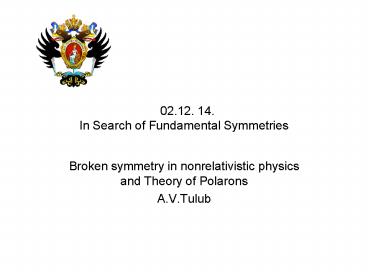02.12. 14. In Search of Fundamental Symmetries - PowerPoint PPT Presentation
Title:
02.12. 14. In Search of Fundamental Symmetries
Description:
02.12. 14. In Search of Fundamental Symmetries Broken symmetry in nonrelativistic physics and Theory of Polarons A.V.Tulub Broken symmetry in non relativistic physics 1. – PowerPoint PPT presentation
Number of Views:75
Avg rating:3.0/5.0
Title: 02.12. 14. In Search of Fundamental Symmetries
1
02.12. 14. In Search of Fundamental Symmetries
- Broken symmetry in nonrelativistic physics and
Theory of Polarons - A.V.Tulub
2
Broken symmetry in non relativistic physics
- 1. Electronic structure calculations
- 2. Molecular structure.
- 3. Translational invariance.
- 4. Polaron theory.
3
Polarons Theory.
Pekar broken symmetry solution arise from the
wave function structure
4
Translational invariance
- 1. S.V. Tyablikov. An Adiabatic Form of
perturbation Theory in the Problem of the
interaction of a particle with a Quantum Field.
JETP.21, P. 377,(1951). - ????? ??????? ?????? ?????????????? ??????????
? ?????? ? ????????, ?????? ??????????????????
???? ????? ?????????? ? ????????????????
???????????? ????????? ??????? ?????? ???????????
????????? ? ???????????? ?????? - 2. Fröhlich, H.Pelzer, S. Zienau. Phil.Mag.
41,221,1951. - ????????, ???????? ?? ???????????, ?????
???????? ???????????? ?? ????????? - .
- ????????? ?.?.
- 3. Translational invariance. The introduction of
a classical field.
Motion of a superfluid in a narrow canal and
Josephson effect. JETP.V. 61,P.1986,1971 (with
B.Lukin)
5
?arge transfer in DNA.
D.Porath et al, Nature, 403, (2000), 635
6
Holstein Hamiltonian
7
DNA-molecule in a practice
??????
8
Literature
- 1. S.I. Pekar. Theory of Polarons. JETP.19,
P.796, (1949). - 2. S.V. Tyablikov. An Adiabatic Form of
perturbation Theory in the Problem of the
interaction of a particle with a - Quantum Field. JETP.21, P.
377,(1951). - 3. T.D. Lee, F. Low, D. Pines. The Motion
of slow Electrons in a Polar Crystal.
Phys.Rev.90,P.297, (1953). - 4.R.P. Feynmann. Slow electrons in a Polar
Crystals. Phys.Rev.V.97, P.660, (1955). - 5. E.P.Gross. Phys.Rev.V.100,1671,(1955).
- 6. A.V.Tulub. Phonon interactions of electrons in
polar crystals.. JETP.V34,P.1641, (1958). - 7. A.V.Tulub. On the theory of cyclotron
resonance in polar crystals. JETP.V38,? 2,P.565.,
(1959). - 8. A.V.Tulub. Mean free path of an exiton in
polar crystals. JETP.V39,? 6,P.1859 (1959). - 9. A.V.Tulub. Recoil Effect in Quantum Field
Theory. Vestnik Leningrad Uni.22,P.104,(1960). - 10. A.V.Tulub. Slow electrons in a Polar
Crystals.JETP.V41,P.1828, (1961). - Present works
- 1 . N. I. Kashirina.Application of Quantum Field
Theory Methods to the Development - of the translation invariant Polaron
and Bipolaron Theory.Ukr.J.Phys.2014,V.59, ?11,
P.2071. - 2. V.D.Lakhno. Large radius Holstein polaron and
the problem of spontaneous - symmetry breaking. Progress in
Theoretical and Experimental Physics.2014 (
Japan). - 3. N. I. Kashirina. V.D.Lakhno, A.V.Tulub.
JETP.,141,924,(2012). - Kashirina
- Weak or intermediate coupling should be
realized in real crystal
9
1 . N. I. Kashirina.Application of Quantum
Field Theory Methods to the Development
of the translation invariant Polaron and
Bipolaron Theory. Ukr.J.Phys.2014,V.59, P.2071.
2. V.D.Lakhno. Large radius Holstein polaron and
the problem of spontaneous symmetry
breaking. Progress in Theoretical and
Experimental Physics.2014 ( Japan).
10
Theory of Polarons.
-
(1) -
Elimination of electron coordinates -
(2) -
Were is the mass of a polaron?
Self interaction field.
11
Scattering. The mean free path
The ground state wave function
Scattering amplitude
Resonance structure of the
scattering amplitude depends on the
value of the coupling constant. Max. value of the
coupling constant.
12
Numerical value. Polaron energy as the function
of coupling constant.
- Try function f of the coupling constant.
- F -NV exp(-k2/2a2)
N. I. Kashirina.Application of Quantum Field
Theory Methods to the Development of the
translation invariant Polaron and Bipolaron
Theory.Ukr.J.Phys.2014,V.59, ?11, P.2071.
13
Instead of an electron an atom. Symmetry
breaking. Difference between left and right
polarization in He-Ne laser.
- 1. N.N. Rozanov, A.V. Tulub// Doklady USSR V.
165,? 6, P.1280.(1965) - 2. N.N. Rozanov, A.V.Tulub // Doklady USSR V.
181,? 4, P.830(1968)
a) quantum field, 2) classical field.
Nonlinear effect in a magnetic field
A. V. Tulub. // New derivation of the of the
formulas of nonlinear susceptibilities. Doklady
USSR .V. 212, ,P. 584 1972.
14
Superconductivity.
- 1. G.M. Eliashberg. Interaction between
electrons and lattice vibrations in a
superconductor JETP.V.38,P.966,(1960).Frolich
Hamiltonian. - 2,
Superconductivity arise primarily from a from
magnetic coupling, induced attraction
interaction. Inverse isotope effect. Journal
Phys. Soc. Japan V.78,? 9,P. 094718
15
Kamihara et al. // Superconductivity in Iron
Compounds. (Journ. Amer.Chem. Soc. V.130,P,3296
(2008).
- Symmetry Braking in a molecular structure.
- Fe(2) molecule in a free space and in the
embedding. Superconductivity arise primarily from
a from magnetic coupling, involving the ground as
well the excited states. - Ground and excited spin states of the molecular
cluster Fe(2)Si(18). - CI method.
16
Fe(2)Si(18). Ferromagnetic coupling. Ground
state.Total spin S4.
- r(Fe1Si14)3.027, r(Fe1Si17)3.029,r(Fe1Si15)2.5
78, r(Fe1Si18)2.578,r(Fe1Si16)2.591,
r(Fe1Si19)2.591,r(Fe1Si8)2.906,
r(Fe1Si5)2.908,r(Fe1Si3)2.951,
r(Fe1Si6)2.952,r(Fe1Si4)2.934,
r(Fe1Si7)2.933,r(Fe1Fe2)2.817,r(Fe2Si8)3.535,
r(Fe2Si5)3.537,r(Fe2Si3)2.833,
r(Fe2Si6)2.834,r(Fe2Si4)2.829,
r(Fe2Si7)2.829,r(Fe2Si20)2.768,
r(Fe2Si11)2.768,r(Fe2Si9)2.647,
r(Fe2Si12)2.648,r(Fe2Si10)2.646,
r(Fe2Si13)2.645 - q(Fe1)1.749, q(Fe2)0.889,q(Si14)0.306,
q(Si17)0.308,q(Si15)-0.432, q(Si18)-0.433,q(S
i16)-0.422, q(Si19)-0.420,q(Si8)-0.003,
q(Si5)-0.002,q(Si3)-0.284, q(Si6)-0.282,q(Si4
)-0.298, q(Si7)-0.300,q(Si20)0.162,
q(Si11)0.163,q(Si9)-0.175, q(Si12)-0.176,q(Si
10)-0.175, q(Si13)-0.174
17
?????? ??????????? ???? Watson - Crick
18
?arge transfer in DNA.
D.Porath et al, Nature, 403, (2000), 635
19
ATP molecule in interaction with Mg(H(2)O(6)
cluster
Grignard-type problem
20
Tubulin
21
??????????? ???????????
22
Crossing of the different singlet and triplet PES
in the case Mg ATP interaction. Coherence.
23
Grignard reaction. Singlet and triplet crossing.
24
????????? ?? ????????Acknowledgements































